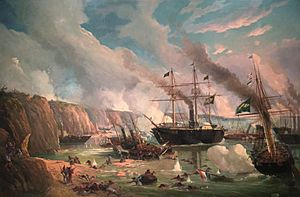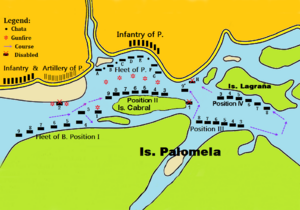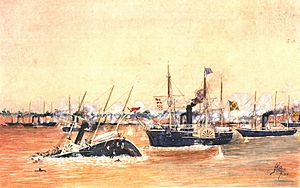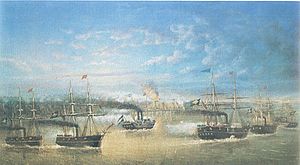Battle of Riachuelo facts for kids
Quick facts for kids Battle of Riachuelo |
|||||||
|---|---|---|---|---|---|---|---|
| Part of the Paraguayan War | |||||||
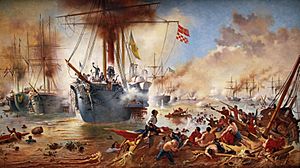 The Battle of Riachuelo (copy by Oscar Pereira da Silva of original by Victor Meirelles) |
|||||||
|
|||||||
| Belligerents | |||||||
| Commanders and leaders | |||||||
| Strength | |||||||
|
Ships:
Forces on land:
|
|||||||
| Casualties and losses | |||||||
|
247:
104 killed123 wounded 20 missing 1 corvette sunk |
||||||
The Battle of Riachuelo was a very important naval battle during the Paraguayan War. It happened between Paraguay and the Empire of Brazil. Before this battle, Paraguay had been winning many fights in the war. But on June 11, 1865, Brazil's navy defeated Paraguay on the Paraná River. This victory started to change the war in favor of Brazil and its allies.
This battle was the biggest naval fight ever between two countries in South America.
Contents
What Was the Plan?
Paraguay's navy was much smaller than Brazil's. On June 9, the Paraguayan fleet arrived at the Fortress of Humaitá. Paraguay's president, Francisco Solano López, planned a surprise attack. He wanted to hit the Brazilian ships that were helping their soldiers on land at Riachuelo.
The Paraguayan force had nine ships and seven barges with cannons. They also had 22 cannons and two rocket batteries on the river bank. In total, they had 44 guns. The Brazilian side had nine ships with 58 guns.
The Paraguayans wanted to attack before sunrise. They knew that most Brazilian soldiers would be sleeping on land. Only a few men would be left to guard the ships. The original plan was for Paraguayan steamers to sneak up to the Brazilian ships. They would then board them quietly in the dark. The Paraguayan ships were mainly there to help protect the boarding parties.
How the Battle Unfolded
The Paraguayan fleet left Humaitá fortress on the night of June 10, 1865. They headed towards the port of Corrientes. President López had given clear orders to approach the Brazilian ships quietly. They were supposed to board them before the sun came up. This would leave the Brazilian land forces without their ships early in the war.
López sent nine steamers, including the Tacuarí and Paraguarí. Captain Meza was in charge, sailing on the Tacuarí. But a few miles from Humaitá, the engine of the Yberá broke down. After trying to fix it for hours, they decided to continue with only eight ships.
The fleet reached Corrientes after sunrise. However, a thick fog still made the surprise attack possible. Most Brazilian soldiers were still on land. But Captain Meza did not follow López's orders. Instead of boarding the ships, he decided to sail past them. The Paraguayan fleet would fire at the Brazilian camp and ships as they went by. The Paraguayans started shooting at 9:25 am.
The Paraguayan ships sailed in a line next to the Brazilian fleet. They continued downstream, firing at the Brazilian ships. The Brazilian soldiers on land quickly got onto their own ships. They began to shoot back. One Paraguayan steamer was hit in its boiler. One of their barges was also damaged. Once out of range, the Paraguayans turned upstream. They anchored their barges in a narrow part of the river. This was meant to trap the Brazilian fleet.
Admiral Barroso, leading the Brazilians, saw what the Paraguayans were doing. He turned his ships downstream to chase them. But the Paraguayans started firing from the shore at the lead Brazilian ship, Belmonte. The second ship, Jequitinhonha, mistakenly turned upstream. The rest of the Brazilian fleet followed it. This left the Belmonte alone to face all the Paraguayan firepower. It was soon put out of action. The Jequitinhonha then got stuck in the mud, becoming an easy target.
Admiral Barroso was on his ship, the Amazonas. He tried to stop the confusion and get his fleet back in order. He decided to lead his ships downstream again. He wanted to fight the Paraguayans and stop them from escaping. Barroso famously told his fleet, "Brazil expects that every man will do his duty!" This was a famous saying from Horatio Nelson. Four Brazilian ships followed the Amazonas.
Captain Meza left his position and attacked the Brazilian line. Three Paraguayan ships went after the Araguari. The Parnaíba stayed near the stuck Jequitinhonha. It was also attacked by three Paraguayan ships trying to board it. The Brazilian line was now split into two. A fierce fight happened on the Parnaíba when the Marquez de Olinda joined the attackers.
Barroso, now heading upstream, decided to try something risky to win the battle. The first ship to face the Amazonas was the Paraguarí. The Amazonas rammed it, putting it out of action. Then, the Amazonas rammed the Marquez de Olinda and the Salto. It also sank a barge. The Paraguari was already out of the fight, so the Paraguayans tried to get away. The Brazilian ships Beberibe and Araguari chased them. They badly damaged the Tacuary and Pirabebé. But night came, stopping them from sinking those ships.
The Jequitinhonha had to be set on fire by the Paraguayans. In the end, Paraguay lost four steamers and all of their barges. Brazil lost only the Jequitinhonha, the ship that caused the early confusion.
What Happened After?
After the battle, the eight remaining Brazilian steamers sailed down the river. President López ordered Major José María Bruguez to move his cannons quickly. He wanted them to wait for and attack the Brazilian fleet as it passed. So, the Brazilian fleet had to sail through heavy fire. On August 12, Bruguez attacked the fleet from high cliffs at Cuevas. Every Brazilian ship was hit, and 21 men were killed.
The Paraguarí, which the Amazonas had rammed, was set on fire by the Brazilians. But it had a metal hull. A few months later, López ordered the Yporá to get the hull. It was towed to the Jejui River and sunk there. Also, one month after the battle, the Yporá returned to the battle site. Under the cover of night, it quietly boarded the remains of the Jequitinhonha and took one of its cannons.
Captain Meza was shot in the chest during the battle on June 11. He survived the battle but died eight days later from his wound. When López heard about Meza's death, he said, "If he had not died from one gunshot, he would have to die from four." He ordered that no officers should go to Meza's funeral.
Manuel Trujillo, a Paraguayan soldier in the battle, remembered being shocked. He said they knew they just needed to board the Brazilian ships. He also recalled that soldiers on the ships shouted, "Let's board the steamers! We came to board them and not to be killed on deck!"
Admiral Barroso changed the battle by cleverly ramming the enemy ships. The Brazilian Navy won a very important victory. General Wenceslao Robles was stopped in Rio Santa Lúcia. The danger to Argentina was gone.
Ships in the Battle
Brazil's Ships
| Unit | Type | Notes |
|---|---|---|
| Amazonas | Frigate | Flagship |
| Belmonte | Corvette | |
| Jequitinhonha | Corvette | |
| Beberibe | Corvette | |
| Parnaíba | Corvette | |
| Ipiranga | Gunboat | |
| Araguari | Gunboat | |
| Iguatemi | Gunboat | |
| Mearim | Gunboat |
Paraguay's Ships
| Unit | Type | Notes |
|---|---|---|
| Tacuarí | Corvette | |
| Ygureí | Steamboat | |
| Marquez de Olinda | Steamboat | Captured from Brazil earlier |
| Salto Guairá | Steamboat | |
| Paraguarí | Corvette | |
| Yporá | Steamboat | Scuttled after the battle |
| Yberá | Steamboat | |
| Pirabebé | Steamboat | Scuttled after the battle |
| Rio Apa | Steamboat | |
| 2 Chatas | Barges | Towed, each with a large gun |
| 5 Chatas | Barges | Towed, each with a gun |
| Shore troops | Land forces | With cannons and rockets |
Images for kids
See also
 In Spanish: Batalla del Riachuelo para niños
In Spanish: Batalla del Riachuelo para niños


